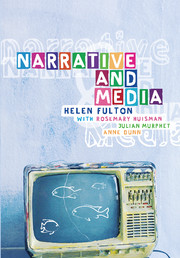Book contents
- Frontmatter
- Contents
- Figures and tables
- Contributors
- Acknowledgements
- 1 Introduction: the power of narrative
- Part 1 The basics of narrative theory
- Part 2 Film as narrative and visual mode
- Part 3 Television: narratives and ideology
- Part 4 Radio and print journalism
- 14 Structures of radio drama
- 15 Radio news and interviews
- 16 Print news as narrative
- 17 Analysing the discourse of news
- Part 5 Popular print culture
- Glossary
- Bibliography
- Index
15 - Radio news and interviews
Published online by Cambridge University Press: 05 June 2012
- Frontmatter
- Contents
- Figures and tables
- Contributors
- Acknowledgements
- 1 Introduction: the power of narrative
- Part 1 The basics of narrative theory
- Part 2 Film as narrative and visual mode
- Part 3 Television: narratives and ideology
- Part 4 Radio and print journalism
- 14 Structures of radio drama
- 15 Radio news and interviews
- 16 Print news as narrative
- 17 Analysing the discourse of news
- Part 5 Popular print culture
- Glossary
- Bibliography
- Index
Summary
No matter what the radio station, ‘the news’ is a distinctive form of radio sound. It is obviously not music, and it differs from other radio ‘talk’ in a number of identifiable ways. News is usually at the ‘top of the clock’; that is, the main bulletins occur on the hour. The fact that news usually starts at the top of the hour is an important part of the way radio structures time throughout the radio day. News on the hour is usually announced with an audio ‘call to attention’. This could be as simple as a voice cue from an announcer or the ‘pips’ of a time signal, or it could be as elaborate as the appropriately named ‘Majestic Fanfare’ that heralds the radio bulletins on the Australian Broadcasting Corporation (ABC), the most widely recognised news theme in Australia. Whatever it might be, nearly all radio stations have some kind of aural cue to the listener that the news is about to begin.
Most radio is live to air; part of establishing the credibility and authenticity of news is that it comes to listeners in the here and now, even though the voice reports of the journalists might have been pre-recorded. In its distinguishing structure and sound, news can be called a genre of radio programming. And just as media theorists and news practitioners distinguish between tabloid and broadsheet newspapers, so we can distinguish subgenres and discourses of radio news.
- Type
- Chapter
- Information
- Narrative and Media , pp. 203 - 217Publisher: Cambridge University PressPrint publication year: 2005



